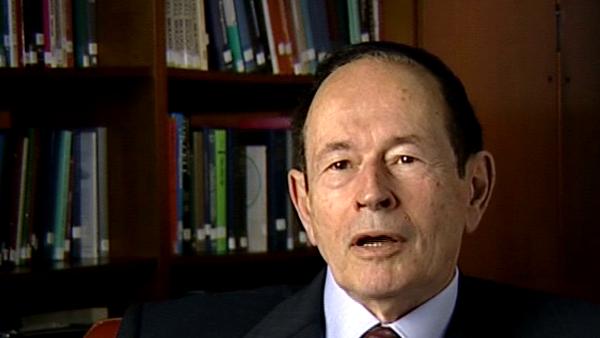NEXT STORY

Proving invertebrates sleep
RELATED STORIES

NEXT STORY

Proving invertebrates sleep
RELATED STORIES


|
Views | Duration | |
|---|---|---|---|
| 41. Michael Merzenich and stroke patients | 537 | 04:18 | |
| 42. Anosognosia | 513 | 01:51 | |
| 43. The importance of the Neurosciences Institute | 506 | 05:09 | |
| 44. The effectiveness of the Neurosciences Institute | 386 | 02:16 | |
| 45. Proving invertebrates sleep | 444 | 03:22 | |
| 46. Brain based device | 537 | 04:01 | |
| 47. Hippocampus and memory | 584 | 04:33 | |
| 48. Philosophy and consciousness: Galileo and Descartes | 1 | 648 | 01:48 |
| 49. Putting the mind back in nature | 1 | 662 | 03:17 |
| 50. A theory of consciousness: The thalamus | 1 | 700 | 03:31 |


We moved from the Rockefeller to this place, for temporary quarters and then, within a year or so, we built this and we then could introduce scientific research at the experimental level. And my aim was to develop a group of people who would work as they pleased but, above all, not rewarded to be specialists but rewarded because they were either interested in solving a problem, a very challenging kind of problem, or to clarify a question. And more or less, give or take, that's happened since then, so I do want to say something about the nature of this kind of place; and I've learned a lot of things from people like Professor Rogers Hollingsworth of Madison, Wisconsin, of the University of Wisconsin, about the kind of characteristics these places have that are effective.
First of all, we're small; we have only 40 scientists. We do not pick people according to specialty per se. We are privately funded in large part, although we're now beginning to expand a bit in governmental support. We do not accept grants that are, how shall I say, connected to careerism, or the idea that your merit depends on how much money you get from the Government. We are very interested in having visiting people come from various areas, particularly older people to tell younger people some war stories about what they shouldn't do; telling young people what they should do is usually a mistake – it doesn't work. But we've had a visiting fellows' program since 1982 of over a thousand scientists from all over the world, coming here to do as they please. The only thing they can't do is have a scientific meeting which involves any kind of politics. And finally we are still the home of Neurosciences Research Program which appoints people by vote to a term of seven years, so we get an access to remarkable specialists from all over the world in an international frame. So this little scientific monastery with these characteristics has been able to do some remarkable things.
US biologist Gerald Edelman (1929-2014) successfully constructed a precise model of an antibody, a protein used by the body to neutralise harmful bacteria or viruses and it was this work that won him the Nobel Prize in Physiology or Medicine in 1972 jointly with Rodney R Porter. He then turned his attention to neuroscience, focusing on neural Darwinism, an influential theory of brain function.
Title: The effectiveness of the Neurosciences Institute
Listeners: Ralph J. Greenspan
Dr. Greenspan has worked on the genetic and neurobiological basis of behavior in fruit flies (Drosophila melanogaster) almost since the inception of the field, studying with one of its founders, Jeffery Hall, at Brandeis University in Massachusetts, where he received his Ph.D. in biology in 1979. He subsequently taught and conducted research at Princeton University and New York University where he ran the W.M. Keck Laboratory of Molecular Neurobiology, relocating to San Diego in 1997 to become a Senior Fellow in Experimental Neurobiology at The Neurosciences Institute. Dr. Greenspan’s research accomplishments include studies of physiological and behavioral consequences of mutations in a neurotransmitter system affecting one of the brain's principal chemical signals, studies making highly localized genetic alterations in the nervous system to alter behavior, molecular identification of genes causing naturally occurring variation in behavior, and the demonstration that the fly has sleep-like and attention-like behavior similar to that of mammals. Dr. Greenspan has been awarded fellowships from the Helen Hay Whitney Foundation, the Searle Scholars Program, the McKnight Foundation, the Sloan Foundation and the Klingenstein Foundation. In addition to authoring research papers in journals such as "Science", "Nature", "Cell", "Neuron", and "Current Biology", he is also author of an article on the subject of genes and behavior for "Scientific American" and several books, including "Genetic Neurobiology" with Jeffrey Hall and William Harris, "Flexibility and Constraint in Behavioral Systems" with C.P. Kyriacou, and "Fly Pushing: The Theory and Practice of Drosophila Genetics", which has become a standard work in all fruit fly laboratories.
Tags: Neurosciences Institute, Neurosciences Research Program, Rogers Hollingsworth, 1982
Duration: 2 minutes, 16 seconds
Date story recorded: July 2005
Date story went live: 24 January 2008